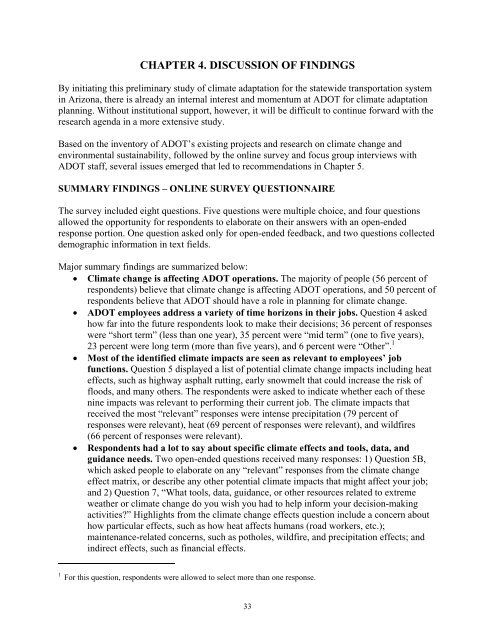SPR-696: Preliminary Study of Climate Adaptation for the Statewide ...
SPR-696: Preliminary Study of Climate Adaptation for the Statewide ...
SPR-696: Preliminary Study of Climate Adaptation for the Statewide ...
Create successful ePaper yourself
Turn your PDF publications into a flip-book with our unique Google optimized e-Paper software.
CHAPTER 4. DISCUSSION OF FINDINGSBy initiating this preliminary study <strong>of</strong> climate adaptation <strong>for</strong> <strong>the</strong> statewide transportation systemin Arizona, <strong>the</strong>re is already an internal interest and momentum at ADOT <strong>for</strong> climate adaptationplanning. Without institutional support, however, it will be difficult to continue <strong>for</strong>ward with <strong>the</strong>research agenda in a more extensive study.Based on <strong>the</strong> inventory <strong>of</strong> ADOT’s existing projects and research on climate change andenvironmental sustainability, followed by <strong>the</strong> online survey and focus group interviews withADOT staff, several issues emerged that led to recommendations in Chapter 5.SUMMARY FINDINGS – ONLINE SURVEY QUESTIONNAIREThe survey included eight questions. Five questions were multiple choice, and four questionsallowed <strong>the</strong> opportunity <strong>for</strong> respondents to elaborate on <strong>the</strong>ir answers with an open-endedresponse portion. One question asked only <strong>for</strong> open-ended feedback, and two questions collecteddemographic in<strong>for</strong>mation in text fields.Major summary findings are summarized below: <strong>Climate</strong> change is affecting ADOT operations. The majority <strong>of</strong> people (56 percent <strong>of</strong>respondents) believe that climate change is affecting ADOT operations, and 50 percent <strong>of</strong>respondents believe that ADOT should have a role in planning <strong>for</strong> climate change. ADOT employees address a variety <strong>of</strong> time horizons in <strong>the</strong>ir jobs. Question 4 askedhow far into <strong>the</strong> future respondents look to make <strong>the</strong>ir decisions; 36 percent <strong>of</strong> responseswere “short term” (less than one year), 35 percent were “mid term” (one to five years),23 percent were long term (more than five years), and 6 percent were “O<strong>the</strong>r”. 1 Most <strong>of</strong> <strong>the</strong> identified climate impacts are seen as relevant to employees’ jobfunctions. Question 5 displayed a list <strong>of</strong> potential climate change impacts including heateffects, such as highway asphalt rutting, early snowmelt that could increase <strong>the</strong> risk <strong>of</strong>floods, and many o<strong>the</strong>rs. The respondents were asked to indicate whe<strong>the</strong>r each <strong>of</strong> <strong>the</strong>senine impacts was relevant to per<strong>for</strong>ming <strong>the</strong>ir current job. The climate impacts thatreceived <strong>the</strong> most “relevant” responses were intense precipitation (79 percent <strong>of</strong>responses were relevant), heat (69 percent <strong>of</strong> responses were relevant), and wildfires(66 percent <strong>of</strong> responses were relevant). Respondents had a lot to say about specific climate effects and tools, data, andguidance needs. Two open-ended questions received many responses: 1) Question 5B,which asked people to elaborate on any “relevant” responses from <strong>the</strong> climate changeeffect matrix, or describe any o<strong>the</strong>r potential climate impacts that might affect your job;and 2) Question 7, “What tools, data, guidance, or o<strong>the</strong>r resources related to extremewea<strong>the</strong>r or climate change do you wish you had to help in<strong>for</strong>m your decision-makingactivities?” Highlights from <strong>the</strong> climate change effects question include a concern abouthow particular effects, such as how heat affects humans (road workers, etc.);maintenance-related concerns, such as potholes, wildfire, and precipitation effects; andindirect effects, such as financial effects.1 For this question, respondents were allowed to select more than one response.33
















